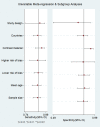Diagnostic accuracy of positron emission tomography/computerized tomography for periprosthetic joint infection of hip: systematic review and meta-analysis
- PMID: 37644493
- PMCID: PMC10466775
- DOI: 10.1186/s13018-023-04061-4
Diagnostic accuracy of positron emission tomography/computerized tomography for periprosthetic joint infection of hip: systematic review and meta-analysis
Erratum in
-
Correction: Diagnostic accuracy of positron emission tomography/computerized tomography for periprosthetic joint infection of hip: systematic review and meta-analysis.J Orthop Surg Res. 2023 Nov 14;18(1):862. doi: 10.1186/s13018-023-04345-9. J Orthop Surg Res. 2023. PMID: 37957663 Free PMC article. No abstract available.
Abstract
Background: American Academy of Orthopaedic Surgeons (AAOS) has provided the guidelines for diagnosing a patient with periprosthetic joint infection including the use of positron emission tomography/computed tomography (PET/CT). Systematic evidence focussing on periprosthetic joint infection (PJI) of hip is limited, which also contains limited number of studies. Hence, the current study aims to perform a pooled analysis of all studies that have assessed the diagnostic accuracy of PET/CT for PJI of hip.
Methods: Searches were done in PubMed Central, EMBASE, MEDLINE, SCOPUS and Cochrane library until December 2022. Meta-analysis was carried out using random-effects model. With 95% confidence intervals (CIs), pooled sensitivity and specificity were reported.
Results: Twenty-six studies met the inclusion criteria. The pooled sensitivity of PET/CT was 89% (95% CI 84-93%), while the pooled specificity was 86% (95% CI 79-91%). The AUROC was 0.94 (95% CI 0.72-0.99). There was statistically significant heterogeneity (p < 0.001) with I2 value of 96%. The diagnostic odds ratio was 52 (95% CI 26-106). Likelihood ratio positive was 6.5 (95% CI 4.1-10.3) and negative was 0.13 (95% CI 0.08-0.19).
Conclusion: Our study found that PET/CT was found to have higher level of accuracy in terms of sensitivity and specificity. Further large-scale research can help to find answers for such questions and provide final conclusive evidence on the inclusion of the imaging modality into the routine clinical practice guidelines for suspected periprosthetic joint infection patients.
Keywords: Diagnostic accuracy; Meta-analysis; Periprosthetic joint infection; Positron emission tomography.
© 2023. BioMed Central Ltd., part of Springer Nature.
Conflict of interest statement
The authors declare that they have no competing interests.
Figures









Similar articles
-
A Systematic Review and Meta-Analysis on the Accuracy of Fluorodeoxyglucose Positron Emission Tomography/ Computerized Tomography for Diagnosing Periprosthetic Joint Infections.Front Surg. 2022 Jun 1;9:698781. doi: 10.3389/fsurg.2022.698781. eCollection 2022. Front Surg. 2022. PMID: 35722526 Free PMC article. Review.
-
Fluorodeoxyglucose positron emission tomography imaging for diagnosing periprosthetic hip infection: the importance of diagnostic criteria.Int Orthop. 2018 Sep;42(9):2025-2034. doi: 10.1007/s00264-018-3931-x. Epub 2018 Apr 20. Int Orthop. 2018. PMID: 29679108
-
A systematic review and meta-analysis of 18F-fluorodeoxyglucose positron emission tomography or positron emission tomography/computed tomography for detection of infected prosthetic vascular grafts.J Vasc Surg. 2019 Jul;70(1):307-313. doi: 10.1016/j.jvs.2019.01.051. Epub 2019 Mar 25. J Vasc Surg. 2019. PMID: 30922755
-
Diagnostic role of PET or PET/CT for prosthetic joint infection: A systematic review and Meta-analysis.Hell J Nucl Med. 2021 Jan-Apr;24(1):83-93. doi: 10.1967/s002449912309. Epub 2021 Apr 20. Hell J Nucl Med. 2021. PMID: 33866342
-
A systematic review and meta-analysis of 18F-fluoro-d-deoxyglucose positron emission tomography interpretation methods in vascular graft and endograft infection.J Vasc Surg. 2020 Dec;72(6):2174-2185.e2. doi: 10.1016/j.jvs.2020.05.065. Epub 2020 Jul 6. J Vasc Surg. 2020. PMID: 32645420
Cited by
-
Correction: Diagnostic accuracy of positron emission tomography/computerized tomography for periprosthetic joint infection of hip: systematic review and meta-analysis.J Orthop Surg Res. 2023 Nov 14;18(1):862. doi: 10.1186/s13018-023-04345-9. J Orthop Surg Res. 2023. PMID: 37957663 Free PMC article. No abstract available.
References
-
- Matharu GS, Culliford DJ, Blom AW, Judge A. Projections for primary hip and knee replacement surgery up to the year 2060: an analysis based on data from The National Joint Registry for England, Wales, Northern Ireland and the Isle of Man. Ann R Coll Surg Engl. 2022;104(6):443–448. doi: 10.1308/rcsann.2021.0206. - DOI - PMC - PubMed
Publication types
MeSH terms
LinkOut - more resources
Full Text Sources
Medical
Miscellaneous

